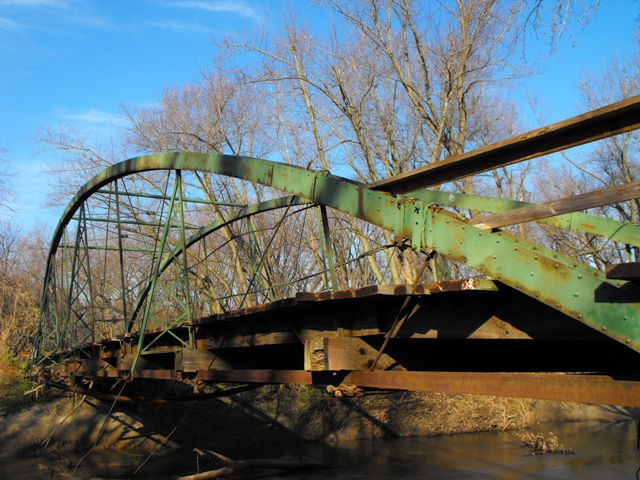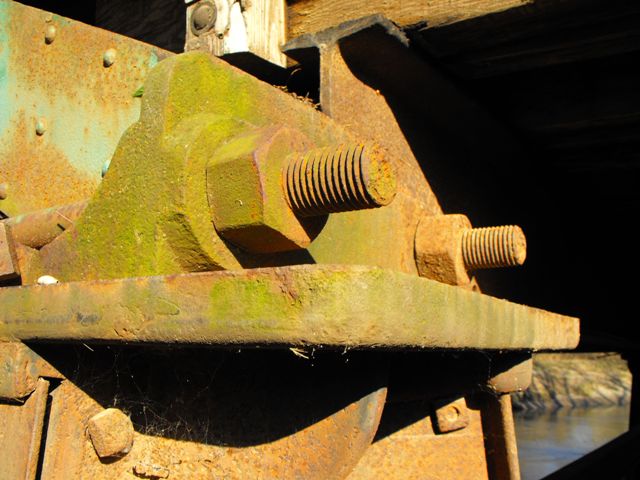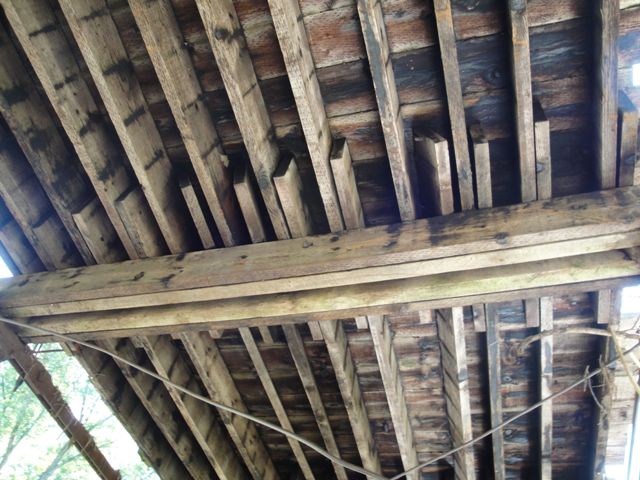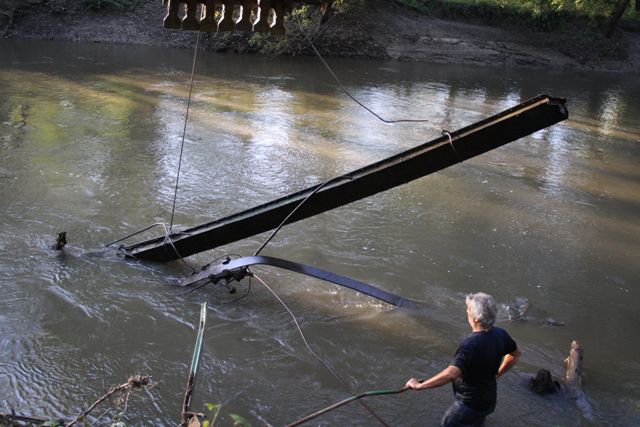We Recommend:
Bach Steel - Experts at historic truss bridge restoration.
BridgeHunter.com Phase 1 is released to the public! - Visit Now
McIntyre Bridge
McDowell Bridge (Incorrect Name) / Skunk River Bridge
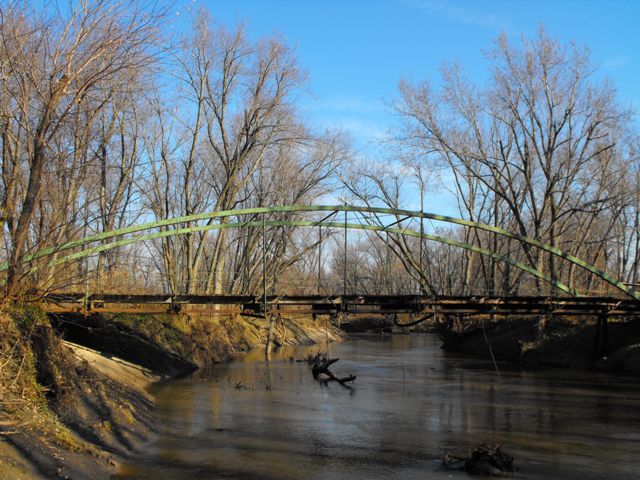
Primary Photographer(s): Nathan Holth
Bridge Documented: November 8, 2009
Rural: Poweshiek County, Iowa: United States
1883 By Builder/Contractor: King Bridge Company of Cleveland, Ohio
Not Available or Not Applicable
120.0 Feet (36.6 Meters)
167.0 Feet (50.9 Meters)
Not Available
1 Main Span(s) and 3 Approach Span(s)
Not Applicable

View Information About HSR Ratings
Bridge Documentation
This bridge has been relocated. This page and its photos and maps document the former location of the bridge.
This bridge has been relocated and preserved for pedestrian use in Auburn Heights Preserve in the State of Delaware. Please also see HistoricBridges.org's page for photos and documentation of the bridge in its current location at Auburn Heights Preserve.
McIntyre Bridge: Introduction
This stunning bridge is a textbook example of the King Iron Bridge Company of Cleveland, Ohio's bowstring truss design. Mostly built in the 1870s, they are one of the rarest and most significant types of bridges in the country. With little to no alterations throughout the entire structure from the top of the trusses down to the base of its piers, the 1883 McIntyre Bridge, a later example of a bowstring truss, retains a remarkably high degree of historic integrity.
The McIntyre Bridge was abandoned by the county engineer in 1986, and has since been owned by the Poweshiek County Conservation Board, the bridge serving a trail at the beautiful Millgrove Access Wildlife Area. In the winter of 2009, the bridge was subjected to impact damage caused by flooding, resulting in damage to the floorbeams, some outriggers, and the truss as a whole also ended up leaning slightly. In response to this, the Conservation Board decided that something needed to be done with this bridge. They are currently working with the Friends of the Skunk River Bridge to develop a comprehensive restoration/preservation solution for this bridge, enabling it to be brought back to life as a functional non-motorized crossing. Before the work could begin however, the damaged bridge succumbed to another flood and was washed into the river. However the determination of the Friends of the Skunk River Bridge combined with bridge restoration experts from Michigan resulted in a determination that the crumpled parts could still be recovered and restored, and so the decision was made to continue towards the goal of a restored bridge. Many might have looked at the bridge after it ended up in the river and thought it would be impossible to restore. The reality is however that the metal in historic bridges is surprisingly durable and resilient if given the proper attention, and while the work of restoring the bridge is no small matter, it isn't as difficult as most might think it would be. The restoration of this bridge will not only be a success for Iowa, it will also demonstrate to both the general public and government agencies that even the most damaged and deteriorated bridges can still be restored, and with less money and effort than is often claimed by so-called experts.
Please consider getting in touch with Friends of the Skunk River Bridge and supporting their efforts through a tax-deductible donation. They also have a blog with the latest news on the status of this bridge Consider also contacting the Poweshiek County Conservation Board and expressing support for a restoration project for this bridge.
Brief Overview of Bowstring Truss Bridges
 Bowstring truss bridges are sometimes called
bowstring arch bridges because they have similarities to both structure
types. Beginning with Squire Whipple's Whipple Arch Bridges, such as the
Ehrmentraut Farm Bridge,
the bowstring truss bridge is the bridge type that began a transition away
from wood and stone and began to make metal a common bridge building
material. It also began a period of experimentation until a good bridge form
was developed, leading to a gradual standardization of bridge design. During
this period, numerous bridge companies all experimented with metal, trying
to design the best bridge. Each company had their own distinctive bowstring
design, including unique and creative design details. These designs were
often patented. Most bowstring truss bridges were built in the 1870s. Also
during this time, cast iron was still used in addition to wrought iron for
the construction of bridges, so many bowstrings built during this period
include details such as connection assemblies that are made of cast iron. By
the 1880s, bridge companies decided that the
pin-connected Pratt truss was a
better structure type, and construction of bowstring bridges sharply dropped
after 1880. Because of the period in which Iowa was first being settled, a
much larger number of bowstring truss bridges were built in the state than
in other states. As a result, even today, Iowa has more historic bowstring
truss bridges than any other state, although the number of bridges statewide
is under 20, a very small number. However, a number of states do not have
even a single historic bowstring truss within their borders. As such, while
bowstring truss bridges are very few in number in Iowa, they are extremely
rare on a national scale. It is imperative that each surviving bowstring in
the county be preserved to protect this key period in bridge building
history.
Bowstring truss bridges are sometimes called
bowstring arch bridges because they have similarities to both structure
types. Beginning with Squire Whipple's Whipple Arch Bridges, such as the
Ehrmentraut Farm Bridge,
the bowstring truss bridge is the bridge type that began a transition away
from wood and stone and began to make metal a common bridge building
material. It also began a period of experimentation until a good bridge form
was developed, leading to a gradual standardization of bridge design. During
this period, numerous bridge companies all experimented with metal, trying
to design the best bridge. Each company had their own distinctive bowstring
design, including unique and creative design details. These designs were
often patented. Most bowstring truss bridges were built in the 1870s. Also
during this time, cast iron was still used in addition to wrought iron for
the construction of bridges, so many bowstrings built during this period
include details such as connection assemblies that are made of cast iron. By
the 1880s, bridge companies decided that the
pin-connected Pratt truss was a
better structure type, and construction of bowstring bridges sharply dropped
after 1880. Because of the period in which Iowa was first being settled, a
much larger number of bowstring truss bridges were built in the state than
in other states. As a result, even today, Iowa has more historic bowstring
truss bridges than any other state, although the number of bridges statewide
is under 20, a very small number. However, a number of states do not have
even a single historic bowstring truss within their borders. As such, while
bowstring truss bridges are very few in number in Iowa, they are extremely
rare on a national scale. It is imperative that each surviving bowstring in
the county be preserved to protect this key period in bridge building
history.
Poweshiek County appears to have only one bridge that is listed or eligible for the National Register of Historic Places, and that is the McIntyre Bridge, the only bowstring truss in the county. Compared to other Iowa counties, Poweshiek County has very few old and historic bridges, and as such, the preservation of the McIntyre bridge is essential not only in the national and statewide context, but especially in the local context.
McIntyre Bridge: The Bowstring Superstructure
 The McIntyre Bridge is an excellent example of the King
Iron Bridge Company's bowstring truss design. Not only is it rare as a
surviving bowstring, it is further significant as an example with little to
no alterations noted on the superstructure. As a result, the bridge provides
a clear look at exactly what the king bowstring design looked like. The
bridge includes typical King bowstring design including a built-up box beam
top chord. Poles/pipes are present on the bridge acting as floorbeams on
some panel points, and also as sway bracing, which is another unusual detail
only usually found on King bowstrings.
The McIntyre Bridge is an excellent example of the King
Iron Bridge Company's bowstring truss design. Not only is it rare as a
surviving bowstring, it is further significant as an example with little to
no alterations noted on the superstructure. As a result, the bridge provides
a clear look at exactly what the king bowstring design looked like. The
bridge includes typical King bowstring design including a built-up box beam
top chord. Poles/pipes are present on the bridge acting as floorbeams on
some panel points, and also as sway bracing, which is another unusual detail
only usually found on King bowstrings.
Remaining floorbeams on the truss are rolled i-beams with very clear labels on them listing "Union Iron Company Buffalo, NY" on them. The only other mill name found on the bridge is "Illinois" located on an i-beam running between the bridge shoes at each end of the bridge.
The outriggers and vertical members on the bridge include the beautiful star-iron members also known as cruciform members, which are a beautiful type of wrought iron rods that only appear in bridges built in the 1870s and the early 1880s. On this bridge's outriggers, the star/cruciform members are connected by a large variable width lattice.
The bottom chord of the bridge are long eyebars whose pin points at the eyes serve only as a flexible splice for the eyebar, and do not hold any other members of the bridge. At the ends of the bridge, the bars taper into threaded rods which are bolted at the bridge shoe.
Additional significance arises from the cast iron components on this bridge all of which remain intact. Most noteworthy are the bottom chord connection assemblies. These beautifully crafted and complex castings provide attachment points for floorbeams, lateral bracing rods, and diagonal members. The bridge shoe is also cast iron and is made to fit into a cast iron bearing plate on the pier, which are both beautiful cast iron details. Cast iron washers are also present on the top chord connections.
An interesting detail is that the builder plaque (the one tiny corner of what's left of it) is located on the outer side of the top chord, located at the north truss, western end. King Bridge Company almost always put their builder plaques on the side of the top chord, but normally the plaque would be on the inner side where people crossing the bridge could see it. Instead, on this bridge, it is on the outside. This is probably because this section was placed on the wrong spot on the truss. For example, this may have been because this section of top chord was placed on the north truss when it should have been placed on the south truss. Because the trusses has symmetry, even with this error, the bridge still fit together and functions correctly.
McIntyre Bridge's Patented Piers
|
The patent for these piers shows that the design included both an open design, and also one which was partially enclosed by wood. The piers on the McIntyre Bridge contain long, loosely hanging bolts which suggest that perhaps the McIntyre Bridge once had these wooden panels on its piers. Drawings by the Historic American Engineering Record for another example of this patented pier show the piers sitting on a log cribbing at the base. The base of the piers is not visible at the McIntyre Bridge, however it seems likely that the McIntyre Bridge's piers also sit on a log cribbing. |
McIntyre Bridge Restoration: Feasible and Essential
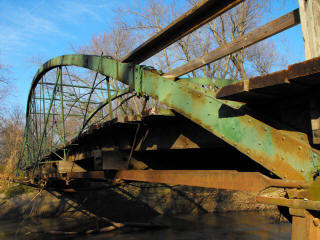 The only acceptable course of action
is the preservation of this essential part of Iowa's rich transportation
heritage. Demolition of a bowstring truss bridge is absolutely unthinkable.
Even in the United States, where historic bridge preservation generally
receives a very low priority, it is unusual (and extremely alarming) to hear
of plans to demolish a bowstring truss bridge. Bowstring truss bridges are
one of the rarest, most unique, and most important historic bridges in the
country. The McIntyre Bridge is significant enough that even the parts that
make up this bridge are rare enough that they could stand on their own in a
museum and be a noteworthy exhibit.
The only acceptable course of action
is the preservation of this essential part of Iowa's rich transportation
heritage. Demolition of a bowstring truss bridge is absolutely unthinkable.
Even in the United States, where historic bridge preservation generally
receives a very low priority, it is unusual (and extremely alarming) to hear
of plans to demolish a bowstring truss bridge. Bowstring truss bridges are
one of the rarest, most unique, and most important historic bridges in the
country. The McIntyre Bridge is significant enough that even the parts that
make up this bridge are rare enough that they could stand on their own in a
museum and be a noteworthy exhibit.
In addition, given the intended reuse of the bridge as a non-motorized facility, it is essential that this bridge be restored in a way that absolutely none of its historic integrity is reduced or compromised. This means that the primary focus must be on retaining and not altering original bridge material. Anything that has failed beyond repair should be replicated and not retrofitted with a modern substitute. For example, failed rivets must be replaced with rivets. Failed rolled American Standard Beams must be replaced with American Standard Beams, not wide flange beams.
Vern Mesler, the historic bridge restoration expert behind the Charlotte Highway Bridge and all the bridges at Historic Bridge Park, as well as several other bridges in Michigan, Indiana, and Ohio, has personally inspected the McIntyre Bridge and found that the bridge can easily be restored despite the damage from the flood. Mesler's work focuses exclusively on true restoration projects where the original bridge material and design is not altered. Upon inspecting the McIntyre Bridge, Mesler found that the actual restoration work is without a doubt the least difficult part of a successful McIntyre Bridge preservation project.
Why is restoration going to be so easy? One of the key things to understand about the McIntyre Bridge is that like many of Iowa's rural truss bridges it enjoys an extremely high degree of structural integrity, most particularly visible in the relatively small amount of pack rust and nearly non-existent section loss on the bridge, even along the traditionally troublesome bottom chord. Located on a dirt road, the McIntyre Bridge has never been exposed to the severely corrosive effects of de-icing salt during the winter season. In addition, its durable wrought and cast iron design rusts far less than modern steel would. The flood damage was mostly limited to isolated areas of bending and the few cracks and breaks that occurred on members can be repaired.
HistoricBridges.org also recommends that the preservation of the existing patented piers for this bridge receive a very high level of priority, while at the same time ensuring that a restored McIntyre Bridge is protected from any future flooding including post-restoration disasters such as befell the Parshallburg Bridge. Both the importance of these piers and the importance of preventing future flood damage cannot be understated. Any engineer hired to work on the bridge should be both sensitive to the national significance of the piers, while also designing a solution that will prevent the McIntyre Bridge from being subjected to the flood damage that is was in 2009. HistoricBridges.org cannot make specific recommendations on how to accomplish this, but one solution might be to reuse the piers but raise the height of the bridge by placing material on the piers.
For a successful McIntyre Bridge restoration project, it will be important to shop for an engineer who will support the kind of restoration that is recommended for this bridge. Such a restoration is not only important, it is feasible. There are engineers in Michigan who have supported this type of restoration, and as such there is no reason why there should not be an engineer in Iowa as well.
Additional Information and Resources
View Historic American Engineering Record (HAER) Overview Of Iowa's Bridges (PDF)Historic American Engineering Record created a large and very informative historical overview and context for Iowa's bridges, and it is offered here by HistoricBridges.org in convenient PDF format for easy printing or offline viewing. The HAER source for the documents composing the PDF is here.
View Bowstring Arch Bridges of Iowa, An Online Book By Michael Finn (PDF)Michael Finn has composed a concise and detailed overview of Iowa's beautiful historic bowstring bridges. It has been made available for free by Iowa Department of Transportation.
View Historic American Engineering Record's Structural Analysis of Iron Bowstring Bridges (PDF)Historic American Engineering Record created a large and very informative structural analysis of how bowstring truss/arch bridges function. Everything from basic discussion of the engineering behind the bridges to advanced mathematical equations are available. The HAER source for the documents composing the PDF is here.
View Structural Analysis of a King Bowstring in Virginia By Elaine Huffman, Virginia Tech Undergraduate (PDF)Huffman's analysis of this small king bowstring in Virginia as described here serves to further explain and understand the function of a bridge like the McIntyre Bridge in ways more detailed than even its builders could have done. Huffman's research included the development of computer models and tests. In addition to the report above, an overview poster is here.
View Historic American Engineering Record (HAER) Documentation For McIntyre BridgeHistoric American Engineering Record completed a documentation of McIntyre Bridge. Their documentation includes both photos and a historical narrative.
View a PDF Version of the HAER Documentation For McIntyre BridgeHistoricBridges.org has converted the HAER data pages that offer a historical narrative for the McIntyre Bridge into a single PDF file for easier offline reading and printing.
View Excerpts From Other HAER Documentation Describing the King Bridge Company's HistoryEach time HAER documents a bridge built by King Bridge Company, they often create a historical narrative for the history of King Bridge Company. HistoricBridges.org has searched through these narratives and offers here a convenient PDF version of two of the longer and more informative narratives.
Adapted HAER Drawings Showing McIntyre Bridge Construction Details (PDF).Historic American Engineering Record never prepared measured drawings for McIntyre Bridge. However, they did create drawings for other King Iron Bridge Company bowstrings. This document shows select measured drawings from other King bowstrings that display details similar or identical to McIntyre Bridge. Measurements and scales have been removed from the document because they would not apply to the McIntyre Bridge. An alternative to the PDF version listed above is a large size GIF version.
View The Patent For The Unique Piers For This Bridge (PDF)The piers on the McIntyre Bridge are a carbon copy of the diagram shown in this patent. View the diagrams in detail and also learn about why these piers were something new and innovative at the time they were patented.
View The First King Bridge Company Bowstring Patent (PDF)Zenas King first patented a bowstring design in 1866. Later, two more patents were issued. These later two patents are closer to the construction date of the McIntyre Bridge, and thus reflect more closely the design seen in the McIntyre Bridge. This is the first patent.
View The Second King Bridge Company Bowstring Patent (PDF)Zenas King first patented a bowstring design in 1866. Later, two more patents were issued. These later two patents are closer to the construction date of the McIntyre Bridge, and thus reflect more closely the design seen in the McIntyre Bridge. This is the second patent.
Information and Findings From Iowa's Historic Bridge InventoryDiscussion of Bridge In June 1883 the Poweshiek County Board of Supervisors ordered the old McIntyre Bridge across the North Skunk River closed because it was no longer safe for the passage of teams. Two months later, on August 7th, the county contracted with William Crickett, an agent representing the Pennsylvania Iron Bridge Works, to replace the bridge with new iron truss. Problems soon arose though, because Crickett had not been forthright in his negotiations with the county. By the time Crickett obtained the contract, he was no longer affiliated with the Pennsylvania firm, although he had failed to inform the county of this fact. When the supervisors became award of Crickett's duplicity, they began to correspond directly with Pennsylvania Iron Bridge, which had been unaware of Crickett's actions. The firm agreed to build the bridge within sixty days for $2,500; but the board, as it took steps to extricate the county from any obligations to Crickett, had hoped for an earlier completion date. Consequently, Pennsylvania Iron Bridge agreed to transfer the contract to the King Iron Bridge and Manufacturing Company of Cleveland. King assumed the contract in November and by the end of the year had erected a bowstring arch-truss on King patent iron piers. Today, the bridge retains a high degree of visual integrity but is closed to vehicular traffic. The bowstring arch-truss was the iron span of choice for Iowa counties in the late 1860s and 1870s. Marketed extensively throughout the Midwest by such industry giants as the King Bridge Company and the Wrought Iron Bridge Company, these often-patented bridge forms featured a wide range of span lengths, economical fabrication cost and relatively quick erection. The proliferation of the bowstring corresponded with the initial development of Iowa's road system; as a result, perhaps thousands of these prototypical iron spans were erected throughout the state. The bowstring had some rather sever structural flaws, however, relating primarily to lateral stability of the arches, and it was largely superseded by the pin-connected truss in the early 1880s. Despite this, some bowstrings were still erected in Iowa in the 1880s, although the number dwindled precipitously by the decade's end. Almost all of Iowa's bowstrings have since been replaced or demolished. Now less than twenty remain in place. Although it no longer carries traffic, the McIntyre Bridge is historically and technologically significant as one of the last remaining examples in the state of what was once a mainstay structural type [adapted from Fraser 1990]. Bridge Considered Historic By Survey: Yes |
![]()
Photo Galleries and Videos: McIntyre Bridge
Structure Overview
Original / Full Size PhotosA collection of overview photos that show the bridge as a whole and general areas of the bridge. This gallery offers photos in the highest available resolution and file size in a touch-friendly popup viewer.
Alternatively, Browse Without Using Viewer
![]()
Structure Details
Original / Full Size PhotosA collection of detail photos that document the parts, construction, and condition of the bridge. This gallery offers photos in the highest available resolution and file size in a touch-friendly popup viewer.
Alternatively, Browse Without Using Viewer
![]()
Friends of Skunk River Bridge Event
Original / Full Size PhotosThe community gathers to learn about and support the bridge. This gallery offers photos in the highest available resolution and file size in a touch-friendly popup viewer.
Alternatively, Browse Without Using Viewer
![]()
Additional Photo-Documentation
Original / Full Size PhotosAdditional photos from Julie Bowers. Mostly detail photos. This gallery offers photos in the highest available resolution and file size in a touch-friendly popup viewer.
Alternatively, Browse Without Using Viewer
![]()
Recovery From River
Original / Full Size PhotosPhotos showing the recovery of the bridge parts from the river and preperation for transport to Michigan for restoration. This gallery offers photos in the highest available resolution and file size in a touch-friendly popup viewer.
Alternatively, Browse Without Using Viewer
![]()
Structure Overview
Mobile Optimized PhotosA collection of overview photos that show the bridge as a whole and general areas of the bridge. This gallery features data-friendly, fast-loading photos in a touch-friendly popup viewer.
Alternatively, Browse Without Using Viewer
![]()
Structure Details
Mobile Optimized PhotosA collection of detail photos that document the parts, construction, and condition of the bridge. This gallery features data-friendly, fast-loading photos in a touch-friendly popup viewer.
Alternatively, Browse Without Using Viewer
![]()
Friends of Skunk River Bridge Event
Mobile Optimized PhotosThe community gathers to learn about and support the bridge. This gallery features data-friendly, fast-loading photos in a touch-friendly popup viewer.
Alternatively, Browse Without Using Viewer
![]()
Additional Photo-Documentation
Mobile Optimized PhotosAdditional photos from Julie Bowers. Mostly detail photos. This gallery features data-friendly, fast-loading photos in a touch-friendly popup viewer.
Alternatively, Browse Without Using Viewer
![]()
Recovery From River
Mobile Optimized PhotosPhotos showing the recovery of the bridge parts from the river and preperation for transport to Michigan for restoration. This gallery features data-friendly, fast-loading photos in a touch-friendly popup viewer.
Alternatively, Browse Without Using Viewer
![]()
Bridge Site After Flood
Full Motion VideoVideo diary showing the vacant bridge site during the operation to recover the bridge parts from the river. Video Credit: Julie Bowers. Streaming video of the bridge. Also includes a higher quality downloadable video for greater clarity or offline viewing.
![]()
Fishing For Bridge Parts
Full Motion VideoRecovery of bridge parts from the river following the flood which washed the bridge into the river. Video Credit: Julie Bowers. Streaming video of the bridge. Also includes a higher quality downloadable video for greater clarity or offline viewing.
![]()
Washing Bridge Parts
Full Motion VideoRecovery of bridge parts from the river following the flood which washed the bridge into the river. Video Credit: Julie Bowers. Streaming video of the bridge. Also includes a higher quality downloadable video for greater clarity or offline viewing.
![]()
Removing Rivets
Full Motion VideoRemoving rivets from a top chord splice to seperate the top chord into smaller sections for transport. Video Credit: Julie Bowers. Streaming video of the bridge. Also includes a higher quality downloadable video for greater clarity or offline viewing.
![]()
Separating Parts
Full Motion VideoSeparating the top chord sections after the splice plate was removed. Video Credit: Julie Bowers. Streaming video of the bridge. Also includes a higher quality downloadable video for greater clarity or offline viewing.
![]()
Heat Straightening
Full Motion VideoHeat straightening a severely twisted bottom chord eyebar. Streaming video of the bridge. Also includes a higher quality downloadable video for greater clarity or offline viewing.
![]()
Moving Bridge Parts
Full Motion VideoRecovery of bridge parts from the river following the flood which washed the bridge into the river. Video Credit: Julie Bowers. Streaming video of the bridge. Also includes a higher quality downloadable video for greater clarity or offline viewing.
![]()
Loading Bridge Parts
Full Motion VideoRecovery of bridge parts from the river following the flood which washed the bridge into the river. Video Credit: Julie Bowers. Streaming video of the bridge. Also includes a higher quality downloadable video for greater clarity or offline viewing.
![]()
Bringing The Parts Out
Full Motion VideoHauling the bridge parts out from the site back to the main road. Streaming video of the bridge. Also includes a higher quality downloadable video for greater clarity or offline viewing.
![]()

Strapping Bridge Parts Down
Full Motion VideoRecovery of bridge parts from the river following the flood which washed the bridge into the river. Video Credit: Julie Bowers. Streaming video of the bridge. Also includes a higher quality downloadable video for greater clarity or offline viewing.
![]()
Maps and Links: McIntyre Bridge
This historic bridge has been relocated and is no longer at this location. See the main bridge page for a link to the new bridge location. This map is shown for reference purposes only.
Coordinates (Latitude, Longitude):
Search For Additional Bridge Listings:
Bridgehunter.com: View listed bridges within 0.5 miles (0.8 kilometers) of this bridge.
Bridgehunter.com: View listed bridges within 10 miles (16 kilometers) of this bridge.
Additional Maps:
Google Streetview (If Available)
GeoHack (Additional Links and Coordinates)
Apple Maps (Via DuckDuckGo Search)
Apple Maps (Apple devices only)
Android: Open Location In Your Map or GPS App
Flickr Gallery (Find Nearby Photos)
Wikimedia Commons (Find Nearby Photos)
Directions Via Sygic For Android
Directions Via Sygic For iOS and Android Dolphin Browser
USGS National Map (United States Only)
Historical USGS Topo Maps (United States Only)
Historic Aerials (United States Only)
CalTopo Maps (United States Only)


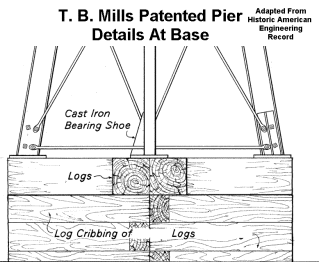 While
often the substructure (piers and abutments) of a historic bridge are much
less significant than the superstructure (the truss), this bridge's piers
are extremely important and significant in their own right. The piers of
this bridge are a unique design, which was
While
often the substructure (piers and abutments) of a historic bridge are much
less significant than the superstructure (the truss), this bridge's piers
are extremely important and significant in their own right. The piers of
this bridge are a unique design, which was
